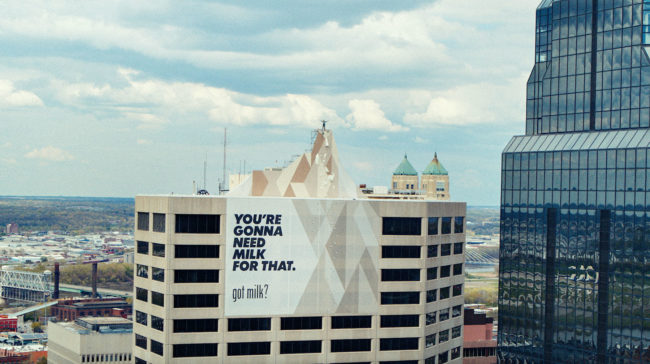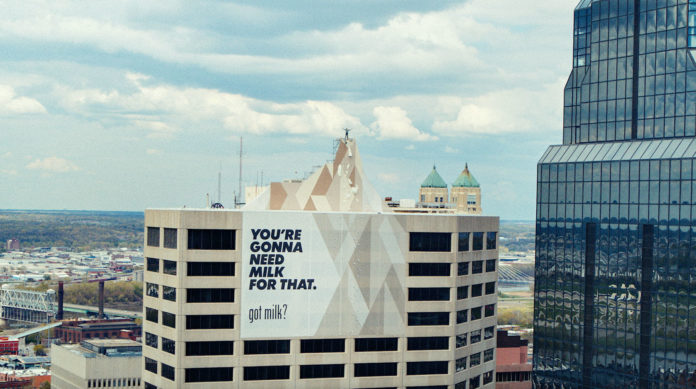Let me just start by saying – I love seeing climbing get major exposure through mainstream channels, even if it’s not “quite right” at times. When climbing’s great athletes, manufacturers, gyms and brands get big time press, it’s awesome. Climbing is not known for making people rich, so I celebrate non-endemic partnerships when they hit the newswire.
Every week, we compile a list of our industry’s top stories in our Insider Weekly, and one such link caught my eye last month. When I first heard about the Milk commercial featuring Kai Lightner, I knew I would be excited to watch it. I adore Kai, his mother Connie, and the nonprofit Climbing For Change they founded. (And I like milk, despite what all the haters say…)
And as expected, I loved it. The two-minute-plus commercial is a fine piece of cinematography by Jimmy Chin. Great angles, intriguing plot, and top-notch production values. Eldorado Wall Company built a sweet wall in a wild place, and the route was visually appealing and looked fun to climb.
“That project was incredibly fun!” Kai Lightner told CBJ after the production. “As a kid, things regularly caught my eye while walking down the street; I would disappear and go climb the strangest things. Of course I usually got in trouble for it, but it was fun! So this project was totally something I would have done. Jimmy’s work is amazing and it was really cool working with him.”
But in addition to garnering appreciation for the project, one point in the commercial did catch the eye of industry insiders watching the film. Right before the two-minute mark (1:50), Kai tops out the route while using an auto belay. For those readers unfamiliar with auto belays, climbing above one is not allowed in climbing facilities, and goes against all manufacturer user manuals.
On a Facebook post which aired part of the ad, multiple comments referenced the auto belay use. “I know for a fact you’re not supposed to top out over an auto belay,” pointed out one user.
So, how dangerous was the auto belay walk-off in the Milk commercial? And can everyday climbers do it too?
Was It Dangerous?
Standing atop a multi-story skyscraper, hundreds of feet above the ground, it would appear Kai is facing a Fall Factor 2 onto static webbing if he were to fall at the top out. A fall under such circumstances would have catastrophic consequences.
However, according to Rich Reynolds, Vice President of Research & Development at Head Rush Technologies―the manufacturer of the TRUBLUE auto belay used in the Milk commercial―the risk was minimized due to the device’s magnetic braking technology.
“Magnetic braking fundamentally has a dampening of impact forces, since the braking does not involve contact with any braking surface,” says Reynolds.
In 2000, Reynolds helped develop the MSA Redpoint auto belay, the first portable auto belay according to Head Rush’s website, which relied on friction braking technology to lower climbers. According to Reynolds and a recent article on Head Rush’s blog, magnetic auto belays are “suitable for dynamic loading and ‘slack’ falls,” whereas the same is “not allowed” for friction auto belays.
That said, even with magnetic braking technology, according to Reynolds a fall at that point in the commercial could still have led to injuries―however a professional climber like Kai would be unlikely to take that fall.
“If Kai would have fallen, the TRUBLUE used would have provided a dynamic belay but the swing into the structure could have resulted in injuries. Because of this, TRUBLUE users are not allowed to climb above the device according to our user manual,” says Reynolds. “Magnetic braking allows for higher freefall. We sell other products using magnetic braking with as much as 6m of freefall. This is not possible on friction devices.”
So, how dangerous was the auto belay walk-off in the Milk commercial? The answer: far less than it could have been.

Can You Do It Too?
As Reynolds emphasizes, gyms and climbers should always stay vigilant in using auto belays properly, whether magnetic or friction-based devices. Auto belays bring wonderful benefits to gyms and most often do not result in injuries, but accidents can happen. When they do, most often human error plays a factor.
In just the past year, an accident at High Exposure involving an auto belay resulted in a $1 million settlement, and Vertical World is fighting a $1 million lawsuit concerning an injured climber who allegedly failed to fully clip in to an auto belay. And just this month, a tragic auto belay accident in Colorado resulted in the death of a single mother of two children. (A GoFundMe has been set-up in support of the family, raising over $20,000.)
Despite the reduced risk to Kai’s climb, it’s still not allowed to climb or fall above an auto belay in everyday use. Owners of auto belays should always follow best industry practices and their device’s specific operation manual. The operation manuals of both Head Rush and Perfect Descent auto belays―popular products used in climbing gyms all around the world―contain lines which read, “Never start descent from above the [Auto Belay].”
“The TRUBLUE auto belay has been designed for climbers’ attachment point to be at or below the nozzle at the start of descent. This is how the product is tested and evaluated,” continues Reynolds. “Always follow the manufacturers’ instructions for use. Stay safe and climb on!”
So, can you do it too? The answer: please never climb or fall above any auto belay.
“…I would never recommend anyone to climb an unknown structure, that high in the air, where your life is totally dependent on the stability of the structure and random equipment, as it was portrayed in the film. Even topping out over an auto belay – none of these things should be attempted under normal circumstances,” says Lightner. “For the set up shown in the film, numerous trials, adjustments, and backup systems were in place. My safety was their highest priority.”

Scott Rennak and Joe Robinson are staff at Climbing Business Journal and enjoy collaborating on many articles here.









